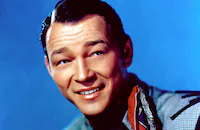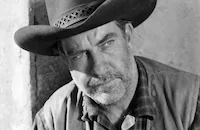The Yellow Rose of Texas
Brief Synopsis
Cast & Crew
Joseph Kane
Roy Rogers
Trigger
Dale Evans
Grant Withers
Harry Shannon
Film Details
Technical Specs

Synopsis
After Sam Weston escapes from prison, where he has served five years for a payroll robbery, insurance investigator Roy Rogers is assigned to find both Weston and the money, which was never recovered. Roy is detailed to follow Sam's daughter Betty, who is suspected of knowing where the loot was stashed. Betty, unaware of Roy's true identity, befriends him when he obtains a singing job on the showboat The Yellow Rose of Texas , on which she also performs. Convinced of Betty's sincerity, Roy defends her when nightclub owner Charlie Goss insults her and implies that she is hiding her father. A brawl starts in Goss's Club Ace, and when Roy is set upon by Goss's henchmen, singing group The Sons of the Pioneers come to his aid, along with bouncer Buster. Roy and his new pals trounce their competition, after which Roy helps The Sons get a job on the showboat. Later, Sam sends his friend, Indian Pete, to Betty, and Roy follows her when she leaves the showboat to meet her father. Roy interrupts their happy reunion, and Betty is disillusioned to learn that Roy has been working undercover to find Sam. When Sam proclaims his innocence and describes what really happened during the holdup, however, Roy agrees to give him forty-eight hours to search for the missing strongbox. Roy and his friends accompany Sam to the canyon where Indian Pete had found a piece of the buckboard Sam was driving for the express company at the time of the robbery, but an anonymous tipster informs the sheriff of their whereabouts and he descends upon them with his posse. Goss's henchman Ferguson shoots at the sheriff, making it look as if Sam was doing the shooting, and injures Sam in the process. Sam disappears, and an upset Roy believes that he has escaped. Roy soon finds Sam hiding in a stable, however, and Sam reasserts his innocence and his willingness to submit to Roy's judgment. Roy apologizes to Sam and Betty for doubting them, then tricks Ferguson into participating in a shooting match, during which he obtains a bullet from Ferguson's gun, which he compares with the one taken from Sam's wound. Roy gives the bullets to express agent Lukas, who is to forward them to Roy's insurance company. Later, Roy rescues Indian Pete's little boy Pinto from a runaway wagon, and in the process, finds the missing strongbox. The box's seal is unbroken, and Roy becomes suspicious of Lukas, who sealed the box originally and tampered with the evidence for the insurance company. In order to entrap Lukas, Roy announces that he will reveal the thief's identity during a performance on the showboat, and Lukas attempts to escape when Roy shows the the box was empty, thereby proving that Lukas stole the money before loading the box on Sam's wagon. The sheriff apprehends Lukas, however, and soon after, Sam, Indian Pete, Pinto and Buster sit in the audience as Roy, Betty and their friends put on a spectacular show.

Director
Joseph Kane
Cast

Roy Rogers
Trigger

Dale Evans

Grant Withers
Harry Shannon
George Cleveland
Wm. Haade
Weldon Heyburn
Hal Taliaferro
Tom London
Dick Botiller
Janet Martin
Bob Nolan And The Sons Of The Pioneers:
Tim Spencer
Hugh Farr
Karl Farr
Ken Carson
Shug Fisher
Don Reynolds
Fred Toones
Jack O'shea

Robert Wilke
Ken Cooper
George Bell
Shirley Van

Emmett Vogan
Charles Sullivan
Lyle Tayo
Si Jenks
Fred Graham
Isabelle Lamal
George Boyce
Joe Evans
Rex Lease

Chester Conklin
Helen Dickson
Irene Mack
Rose Plumer
Crew
Ed Borschell
Ken Carson
Larry Ceballos
Eddie Cherkose
Albert Debru
Harry Grey
Virgil Hart
Charles Henderson
Russ Kimball
Jack Marta
Tony Martinelli
Sol Meyer
Vic Mizzy
Bob Nolan
Fred A. Ritter
Guy Savage
Armand Schaefer
Morton Scott
Art Siteman
Tim Spencer
Jule Styne
Irving Taylor
Charles Thompson
Jack Townley

Film Details
Technical Specs

Quotes
Trivia
Notes
Some of the above credits were taken from a Republic Pictures "Official Billing" sheet contained in the film's file at AMPAS. Although the billing sheet credits Fred A. Ritter as art director, reviews list Russ Kimball in that position. Most of the songs were missing from the print viewed and additional songs not listed above May have been included in the film. Although a Hollywood Reporter news item noted that Dale Evans was writing song lyrics for the film, her writing contribution has not been confirmed. The picture marked the screen debut of child actor Don Reynolds, who was also known as Little Brown Jug, Don "Brown Jug" Reynolds and Don Kay Reynolds. Modern sources include John Dilson, William Desmond and Horace B. Carpenter in the cast.












